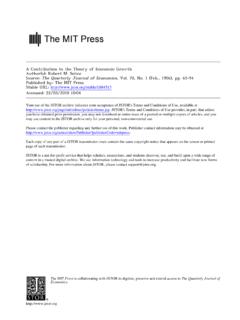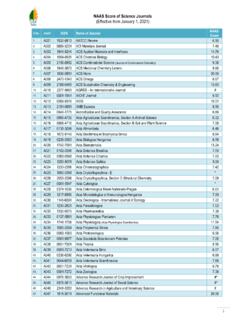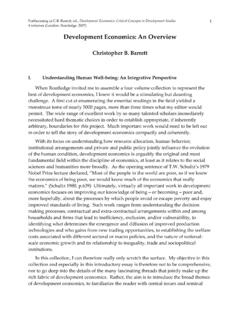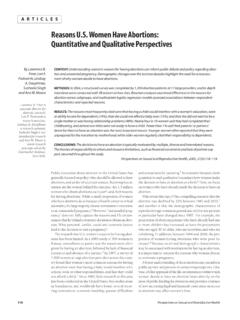Transcription of Economic Growth in a Cross Section of Countries Robert J.
1 Economic Growth in a Cross Section of CountriesRobert J. BarroThe Quarterly journal of Economics, Vol. 106, No. 2. (May, 1991), pp. URL: Quarterly journal of Economicsis currently published by The MIT use of the JSTOR archive indicates your acceptance of JSTOR's Terms and Conditions of Use, available JSTOR's Terms and Conditions of Use provides, in part, that unless you have obtainedprior permission, you may not download an entire issue of a journal or multiple copies of articles, and you may use content inthe JSTOR archive only for your personal, non-commercial contact the publisher regarding any further use of this work.
2 Publisher contact information may be obtained copy of any part of a JSTOR transmission must contain the same copyright notice that appears on the screen or printedpage of such JSTOR Archive is a trusted digital repository providing for long-term preservation and access to leading academicjournals and scholarly literature from around the world. The Archive is supported by libraries, scholarly societies, publishers,and foundations. It is an initiative of JSTOR, a not-for-profit organization with a mission to help the scholarly community takeadvantage of advances in technology. For more information regarding JSTOR, please contact Aug 12 09:47:28 2007 Economic Growth IN A Cross Section OF Countries " For 98 Countries in the period 1960-1985, the Growth rate of real per capita GDP is positively related to initial human capital (proxied by 1960 school- enrollment rates) and negatively related to the initial (1960) level of real per capita GDP.
3 Countries with higher human capital also have lower fertility rates and higher ratios of physical investment to GDP. Growth is inversely related to the share of government consumption in GDP, but insignificantly related to the share of public investment. Growth rates are positively related to measures of political stability and inversely related to a proxy for market distortions. In neoclassical Growth models, such as Solow [19561, Cass [19651, and Koopmans [1965], a country's per capita Growth rate tends to be inversely related to its starting level of income per person. In particular, if Countries are similar with respect to structural parameters for preferences and technology, then poor Countries tend to grow faster than rich Countries .]]
4 Thus, there is a force that promotes convergence in levels of per capita income across Countries .' The main element behind the convergence result in neoclassi- cal Growth models is diminishing returns to reproducible capital. Poor Countries , with low ratios of capital to labor, have high marginal products of capital and thereby tend to grow at high rates.' This tendency for low-income Countries to grow at high rates is reinforced in extensions of the neoclassical models that allow for international mobility of capital and technology. The hypothesis that poor Countries tend to grow faster than rich Countries seems to be inconsistent with the Cross -country evidence, which indicates that per capita Growth rates have little *Anearlier version of this paper was presented at the Institute for the Study of Free Enterprise Systems' Conference on Human Capital and Economic Growth , SUNY, Buffalo, May 1989.
5 I am ateful for suggestions from Olivier Blanchard and for research assistance from ~oger wolf and David Renelt. 1. Barro and Sala i Martin [1990] show that the tendency for poor Countries to grow faster than rich Countries , termed P-convergence, need not imply a reduction in the dispersion of income levels, termed u-convergence, if each country's level of income is continually subject to random disturbances. The present study deals only with P-convergence. 2. This property holds unambiguously for the capital stock in the Cass [1965]-Koopmans [I9651 model if the elasticity of marginal utility is constant. It also holds unambiguously for output if the production function is Cobb-Douglas.]
6 See Barro and Sala i Martin [1991]. o1991 by the President and Fellows of Harvard College and the Massachusetts Institute of Technology. The Quarterly journal of Economics, May 1991 408 QUARTERLY journal OF ECONOMICS FIGUREI Per Capita Growth Rate Versus 1960 GDP per Capita correlation with the starting level of per capita product. Figure I, which uses the data from the Summers and Heston [I9881 international comparison project, shows this type of relationship for 98 Countries . The average Growth rate of per capita real gross domestic product (GDP) from 1960 to 1985 (denoted GR6085) is not significantly related to the 1960 value of real per capita GDP (GDPGO); the correlation is This finding accords with recent models, such as Lucas [I9881 and Rebelo [19901, that assume constant returns to a broad concept of reproducible capital, which includes human capital.]]]
7 In these models the Growth rate of per capita product is independent of the starting level of per capita product. Human capital plays a special role in a number of models of endogenous Economic Growth . In Romer [I9901 human capital is 3. I use throughout the values of GDP expressed in terms of prices for the base year, using chain-weighted values of GDP are not very different. Economic Growth IN A Cross Section OF Countries 409 the key input to the research sector, which generates the new products or ideas that underlie technological progress. Thus, Countries with greater initial stocks of human capital experience a more rapid rate of introduction of new goods and thereby tend to grow faster.]
8 In multicountry models of technological change, the spread of new ideas across Countries (or firms or industries) is also important. As Nelson and Phelps [I9661 suggested, a larger stock of human capital makes it easier for a country to absorb the new products or ideas that have been discovered elsewhere. Therefore, a follower country with more human capital tends to grow faster because it catches up more rapidly to the technological leader. Becker, Murphy, and Tamura [I9901 assume that the rate of return on human capital increases over some range, an effect that could arise because of the spillover benefits from human capital that Lucas [19881 stresses.]]]
9 As an example, the return to some kinds of ability, such as talent in communications, is higher if other people are also more able. In this setting, increases in the quantity of human capital per person tend to lead to higher rates of investment in human and physical capital, and hence, to higher per capita Growth . A supporting force is that more human capital per person reduces fertility rates, because human capital is more productive in producing goods and additional human capital rather than more children. The empirical enalysis in this paper uses school-enrollment rates as proxies for human capital. For a given starting value of per capita GDP, a country's subsequent Growth rate is positively related to these measures of initial human capital.
10 Moreover, given the human-capital variables, subsequent Growth is substantially negatively related to the initial level of per capita GDP. Thus, in this modified sense, the data support the convergence hypothesis of neoclassical Growth models. A poor country tends to grow faster than a rich country, but only for a given quantity of human capital; that is, only if the poor country's human capital exceeds the amount that typically accompanies the low level of per capita income. I. RESULTSFOR GROWTHRATESOF GDP Basic Results Table I shows regressions for annual average Growth rates of per capita real GDP. Most of the results apply from 1960 to 1985 to a Cross Section of 98 Countries (the largest number of Countries on QUARTERLY journal OF ECONOMICS m w6 mG w cow t-rl "0 w 00 cn 1 99 99 1 I 7s m - rl A % g !)




